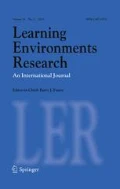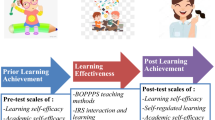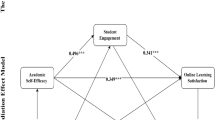Abstract
Self-efficacy for learning, which refers to students’ beliefs in their capabilities to regulate their own learning, could determine students’ motivation and academic achievement and, therefore, is significant in the learning process. This study examined how educational efforts based on constructivist theory were associated with the self-efficacy beliefs of students within higher education settings. Perceived constructivist pedagogical principles and academic self-efficacy were measured for a sample of 167 undergraduate college students studying in a Problem-Based Learning environment (PBL) informed by constructivist theory, and in a traditional lecture-based environment which used conventional instruction. The main aims were to compare the different learning environments and to identify which perceived constructivist dimensions in the PBL environment were more contributive to academic self-efficacy beliefs. Multivariate analysis of covariance, path analysis and regression analysis showed that students in the PBL course perceived the learning environment as more constructivists and having high academic self-efficacy relative to the lecture-based environment. The construct ‘motivation towards reflections and concept investigation’ (the extent to which high-order meta-cognitive learning functions towards knowledge are stimulated) was the most dominant positive predictor of academic self-efficacy. Implications of these findings are discussed.


Similar content being viewed by others
References
Alexander, P. A. (2003, August). Expertise and academic development: A new perspective on a classic theme. Paper presented at the 10th biennial conference of the European Association for Research on Learning and Instruction, Padua, Italy.
Alexander, P. A., & Murphy, P. K. (1998). Profiling the differences in students’ knowledge, interest and strategic processing. Journal of Educational Psychology, 90, 435–447.
Bandura, A. (1977). Social learning theory. New York: Prentice Hall.
Bandura, A. (1986). The explanatory and predictive scope of self-efficacy theory. Journal of Social and Clinical Psychology, 4, 359–373.
Bandura, A. (1993). Perceived self-efficacy in cognitive development and functioning. Educational Psychologist, 28, 117–149.
Bandura, A. (1997). Self-efficacy: The exercise of control. New York: Freeman.
Bandura, A., Barbaranelli, C., Caprara, G. V., & Pastorelli, C. (2001). Self-efficacy beliefs as shapers of children’s aspirations and career trajectories. Child Development, 72, 187–206.
Barrows, H. S. (1996). Problem-based learning in medicine and beyond. In L. Wilkerson & W. H. Gijselaers (Eds.), Bringing problem-based learning to higher education: Theory and practice (New Directions for Teaching and Learning, Vol. 68, pp. 3–13). San Francisco: Jossey-Bass Inc. Publishers.
Bentler, P. M. (2006). EQS 6 structural equations program manual. Encino, CA: Multivariate Software Inc.
Bong, M. (2001). Role of self-efficacy and task-value in predicting college students’ course performance and future enrollment intentions. Contemporary Educational Psychology, 26, 553–570.
Bong, M., & Skaalvik, E. M. (2003). Academic self-concept and self-efficacy: How different are they really? Educational Psychology Review, 15, 1–40.
Brooks, J. G., & Brooks, M. G. (1999). In search of understanding: The case for constructivist classrooms. Alexandria, VA: Association for Supervision and Curriculum Development.
Carroll, A., Houghton, S., Wood, R., Unsworth, K. L., Hattie, J., Gordon, L., & Bower, J. (2009). Self-efficacy and academic achievement in Australian high school students: The mediating effects of academic aspirations and delinquency. Journal of Adolescence, 32, 797–817.
Christianson, R. G., & Fisher, K. M. (1999). Comparison of student learning about diffusion and osmosis in constructivist and traditional classrooms. International Journal of Science Education, 21, 687–698.
Como, L., & Snow, E. R. (1986). Adapting teaching to individual differences among learners. In M. C. Wittrock (Ed.), Handbook of research on teaching (3rd ed., pp. 605–629). New York: Macmillan.
De Kock, A., Sleegers, P., & Voeten, M. J. M. (2004). Learning and classification of learning environments in secondary education. Review of Educational Research, 74, 141–170.
DeBacker, T. K., & Nelson, R. M. (2000). Motivation to learn science: Differences related to gender, class type, and ability. Journal of Educational Research, 93, 245–255.
den Brok, P., Fisher, D., Rickards, T., & Bull, E. (2006). Californian science students’ perceptions of their classroom learning environments. Educational Research and Evaluation, 12, 3–25.
Dewey, J. (1938). Experience and education. New York: Touchstone.
Dorman, J. P. (2001). Associations between classroom environment and academic efficacy. Learning Environments Research, 4, 243–257.
Dorman, J. P., & Adams, J. (2004). Associations between students’ perceptions of classroom environment and academic efficacy in Australian and British secondary schools. Westminster Studies in Education, 27, 69–85.
Dorman, J. P., Fisher, D., & Waldrip, B. (2006). Classroom environment and students` perceptions of assessment, academic efficacy and attitude to science: A LISREL analysis. In D. L. Fisher & M. S. Khine (Eds.), Contemporary approaches to research on learning environments: World views (pp. 1–28). Singapore: World Scientific.
Eccles, J. S., & Wigfield, A. (2002). Motivational beliefs, values, and goals. Annual Review of Psychology, 53, 109–132.
Fisher, D. L., Fraser, B. J., & Rickards, T. (1997, April). Gender and cultural differences in teacher-student interpersonal behavior. Paper presented at the annual meeting of the American Educational Research Association, Chicago, IL.
Fisher, D., & Taylor, P. (1997). A questionnaire for monitoring social constructivist reform in university teaching. In R. Pospisil & L. Willcoxson (Eds.), Learning through teaching (pp. 100–105). Retrieved from http://otl.curtin.edu.au/tlf/tlf1997/fisher.html
Fraser, B. J., Fisher, D. L., & McRobbie, C. J. (1996, April). Development, validation, and use of personal and class forms of a new classroom environment instrument. Paper presented at the annual meeting of the American Educational Research Association, New York.
Freire, P. (1970). Pedagogy of the oppressed. New York: Continuum.
Gijbels, D., van de Watering, G., Dochy, F., & van den Bossche, P. (2006). New learning environments and constructivism: The students’ perspective. Instructional Science, 34, 213–226.
Gurvitch, R., & Metzler, M. W. (2009). The effects of laboratory-based and field-based practicum experience on pre-service teachers’ self-efficacy. Training and Teacher Education, 25, 437–443.
Hackett, G., Betz, N. E., Casas, J. M., & Rocha-Singh, I. A. (1992). Gender, ethnicity, and social cognitive factors predicting the academic achievement of students in engineering. Journal of Counseling Psychology, 39, 527–538.
Hay, K. E., & Barab, S. A. (2001). Constructivism in practice: A comparison and contrast between apprenticeship and constructionist learning environments. The Journal of the Learning Sciences, 10, 281–322.
Kim, J. S. (2005). The effects of constructivist teaching approach on student academic achievement, self concept, and learning strategies. Asia Pacific Education Review, 6, 7–19.
King, T. (2002, July). Development of student skills in reflective writing. Paper presented at the 4th World Conference of the International Consortium for Educational Development in Higher Education, Perth, Australia.
Kirschner, P. A., Sweller, J., & Clark, R. E. (2006). Why minimal guidance during instruction does not work: An analysis of the failure of constructivist, discovery, problem-based experiential and inquiry-based teaching. Educational Psychologist, 41(2), 75–86.
Koul, R. B., & Fisher, D. (2002, December). Science classroom learning environments in India. Paper presented at the International Educational Research Conference of the Australian Association for Research in Education (AARE), Brisbane, Australia.
Lakoff, G. (1987). Women, fire, and dangerous things. Chicago: University of Chicago Press.
Lent, R. W., Brown, S. D., & Larkin, K. C. (1987). Comparison of three theoretically derived variables in predicting career and academic behavior: Self-efficacy, interest congruence, and consequence thinking. Journal of Counseling Psychology, 34, 293–298.
Linnenbrink, E. A., & Pintrich, P. R. (2002). Motivation as an enabler for academic success. School Psychology Review, 31, 313–327.
Loyens, S. M. M., & Gijbels, D. (2008). Understanding the effects of constructivist learning environments: Introducing a multi-directional approach. Instructional Science, 36, 351–357.
Loyens, S. M. M., Rikers, R. M. J. P., & Schmidt, H. G. (2008). Relationships between students’ conceptions of constructivist learning and their regulation and processing strategies. Instructional Science, 36, 445–462.
Mandl, H., Gruber, H., & Renkl, A. (1996). Communities of practice toward expertise: Social foundation of university instruction. In P. B. Baltes & U. Staudinger (Eds.), Interactive minds: Life-span perspectives on the social foundation of cognition (pp. 394–411). Cambridge, UK: Cambridge University Press.
Margianti, E. S., Fraser, B. J., & Aldridge, J. M. (2001, December). Investigating the learning environment and students’ outcomes at the university level in Indonesia. Paper Presented at the annual meeting of the Australian Association for Research in Education (AARE), Fremantle, Western Australia.
Merrill, M. D., Drake, L., Lacy, M., Pratt, J. A., & ID2 Research Group. (1996). Instructional design. Educational Technology, 36(5), 5–7.
Multon, K. D., Brown, S. D., & Lent, R. W. (1991). Relation of self-efficacy beliefs to academic outcomes: A meta-analytic investigation. Journal of Counseling Psychology, 38, 30–38.
Myint, S. K., & Goh, S. C. (2001, December). Investigation of tertiary classroom learning environment in Singapore. Paper presented at the International Educational Research Conference, Australian Association for Educational Research (AARE), University of Notre Dame, Fremantle, Western Australia.
Pajares, F., & Urdan, T. (2006). Foreword. In F. Pajares & T. Urdan (Eds.), Self efficacy beliefs of adolescents (3rd ed., pp. ix–xii). Greenwich, CT: Information Age Publishing.
Papert, S. (1980). Mindstorms: Children, computers, and powerful ideas. New York: Basic Books Inc.
Pintrich, P. R., & DeGroot, E. V. (1990). Motivational and self-regulated learning components of classroom academic performance. Journal of Educational Psychology, 82, 33–40.
Pintrich, P. R., Smith, D., Garcia, T., & Mckeachie, W. (1993). Reliability and predictive validity of the motivated strategies for learning questionnaire (MSLQ). Educational and Psychological Measurement, 53, 801–813.
Raykov, T., & Marcoulidies, G. A. (2000). A first course in structural equation modeling. Mahwah, NJ: Erlbaum.
Schunk, D. H. (1987). Peer models and children’s behavioral change. Review of Educational Research, 57, 149–174.
Schunk, D. H. (2003). Self-efficacy for reading and writing: Influence of modeling, goal setting and self-evaluation. Reading and Writing Quarterly: Overcoming Learning Difficulties, 19, 159–172.
Schunk, D. H., & Ertmer, P. A. (1999). Self-regulatory processes during computer skill acquisition: Goal and self-evaluative influences. Journal of Educational Psychology, 91, 251–260.
Schunk, D. H., & Miller, S. D. (2002). Self-efficacy and adolescents’ motivation. In F. Pajares & T. Urdan (Eds.), Academic motivation of adolescents (pp. 29–52). Greenwich, CT: Information Age.
Schunk, D. H., & Pajares, F. (2002). The development of academic self-efficacy. In A. Wigfield & J. Eccles (Eds.), Development of achievement motivation (pp. 16–31). San Diego: Academic Press.
Steffe, L. P., & Gale, J. (1995). Constructivism in education. Mahwah, NJ: Lawrence Erlbaum Associates.
Taylor, P., Fraser, B., & Fisher, D. (1997). Monitoring constructivist classroom learning environments. International Journal of Educational Research, 27, 293–302.
Tenenbaum, G., Naidu, S., Jegede, O., & Austin, J. (2001). Constructivist pedagogy in conventional on-campus and distance learning practice: An exploratory investigation. Learning and Instruction, 11, 87–111.
Tobin, K. E. (1993). The practice of constructivism in science education. Washington, DC: Association for the Advancement of Science (AAAS).
Tynjälä, P. (1999). Towards expert knowledge? A comparison between a constructivist and a traditional learning environment in the university. International Journal of Educational Research, 33, 355–442.
Urdan, T., & Turner, J. C. (2005). Competence motivation in the classroom. In A. J. Elliot & C. S. Dweck (Eds.), Handbook of competence and motivation (pp. 297–317). New York: The Guilford Press.
van Dinther, M., Filip, D., & Segers, M. (2011). Factors affecting students’ self-efficacy in higher education. Educational Research Review, 6, 95–108.
Vosniadou, S. (2001). How children learn [Educational Practices Series 7]. Brussels: International Academy of Education.
Vrasidas, C. (2000). Constructivism versus objectivism: Implications for interaction, course design, and evaluation in distance education. International Journal of Educational Telecommunications, 6, 339–362.
Vygotsky, L. S. (1978). Mind and society: The development of higher mental processes. Cambridge, MA: Harvard University Press.
Vygotsky, L. S. (1986). Thought and language. Cambridge, MA: MIT Press.
Weinstein, C. E., & Palmer, D. R. (2002). Learning and Study Strategies Inventory (LASSI): User’s manual (2nd ed.). Clearwater, FL: H & H Publishing.
Windschitl, M. (2002). Framing constructivism in practice as the negotiation of dilemmas: An analysis of the conceptual, pedagogical, cultural, and political challenges facing teachers. Review of Educational Research, 72, 131–175.
Wyatt, T. H., Krauskopf, P. B., Gaylord, N. M., Ward, A., Huffstutler-Hawkins, S., & Goodwin, L. (2010). Cooperative M-learning with nurse practitioner students. Nursing Education Perspectives, 31(2), 109–113.
Zimmerman, B. J. (1990). Self-regulating academic learning and achievement: The emergence of a social cognitive perspective. Educational Psychology Review, 2, 173–201.
Zimmerman, B. J. (1998). Developing self-fulfilling cycles of academic regulation: An analysis of exemplary instructional models. In D. H. Schunk & B. J. Zimmerman (Eds.), Self-regulated learning: From teaching to self-reflective practice (pp. 1–19). New York: Guilford Press.
Zimmerman, B. J., Bandura, A., & Martinez-Pons, M. (1992). Self-motivation for academic attainment: The role of self-efficacy beliefs and personal goal setting. American Educational Research Journal, 29, 663–676.
Author information
Authors and Affiliations
Corresponding author
Rights and permissions
About this article
Cite this article
Alt, D. Assessing the contribution of a constructivist learning environment to academic self-efficacy in higher education. Learning Environ Res 18, 47–67 (2015). https://doi.org/10.1007/s10984-015-9174-5
Received:
Accepted:
Published:
Issue Date:
DOI: https://doi.org/10.1007/s10984-015-9174-5




